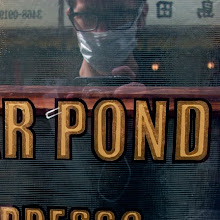An excellent benefit of VOLTA's solo-artist presentation is the wealth of space to work with, even if that space is a booth no larger than that at the Armory or other fairs (or smaller!). The VOLTA artist can customize their space into an environment that accentuates the art and, when placed adjacent to a gallery w/ the same notion — meaning creating a special space for their art, as no two booths look anything like, not at VOLTA — loads of interesting, kinetic relationships inevitably develop. To the point that the art interacts w/ the greater fair space and beyond.
This point is evident even before you take the lifts up to the fair floor. Jan Vormann (represented by Jarmuschek + Partner, Berlin, Booth V8 — and one of of the few double-artist instances, but since his art is not in the booth it works) has instances of his 'Dispatchwork New York', site-specific Lego brick interventions about the city and, lucky for us, on several panels of the lifts. Upstairs at VOLTA's entrance area, Misako Inaoka (Johansson Projects, Oakland, Booth C8) converted one of the structural pillars into a trunk for her fantasy woodland creatures and fungi. Whitish plaster-colored birds, mushrooms, branches, and fantastical chimeras (like this unicorn w/ bird-wings and a squirrel tail) extend out into space and, in a few cases, move about and chirp. There's another thing you might have noticed when exiting the lifts and deciding where you'd like to proceed into VOLTA: this persistent hammering sound amid the hum of human voices and ambient noise. That's from Todd Pavilsko's "Centerpiece" (samsøn, Boston, E2), which I've written about before. If you've seen this bracing, 13min video of the artist methodically driving a nail through his foot, then the recurring sound of the hammer is no longer a static, anonymous sound in the din: you'll give pause, maybe feel a shiver down your spine as you recall those 10+ minutes of agony and then Pavlisko's steady limp away off-camera, and the discomfort you were feeling as a passive participant in the ritual by watching his piece.
Many of the booths have gone to various lengths to customize their space. Sometimes a simple paint-job, converting a white cube into something else very different, is all it takes. I found Sverre Bjertnes' space, at Galleri K in Oslo (Booth F9) rather like a lucid dream in the deep gray wall color, which works quite well w/ his enormous, illusory oil paintings. Priska C. Juska's booth (D9, NYC) did a knockout job on creating the impression of a library for Dannielle Tegeder's suite of geometric works on paper, each uniquely framed and lined on several bookshelves running the length of two walls. I also thought the cardboard tower at the Schuebbe Projects space (Booth F9, Dusseldorf) was the perfect match for Franz Burkhardt's vintage-y representational works on paper, that the weathered look of the various papers played so nicely off the cardboard backing.
I think the tastiest interaction b/w galleries is most readily seen in this sort of 'grove' square bisecting Thomas Erben Gallery (NYC/D11) and Charest-Weinberg (Miami/D10). Erben is showing Dona Nelson's wicked largish, dynamic abstract paintings, including a standout canvas in her intriguing double-sided style. The deep greens in these works echoes so perfectly w/ the action across the hall, a 'Garden of Eden' vitrine by Richard Dupont, he of the polyurethane resin humanoids modeled from computer renderings of his own body. This graphite-toned female and male interact w/ wavy nylon-composed trees (which look like deliciously green seaweed, if you somehow suspended the motion of that plant in mid-drift). This installation, plus Dupont's large C-prints of enlarged leaves from Central Park, plays so well off the green vibes coming from Nelson's works that the booths enhance one another. There is a lot of this shared energy at this fair, I think to the benefit of all.
skip to main |
skip to sidebar

